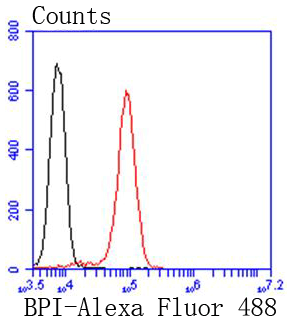Product Detail
Product NameBPI Rabbit mAb
Clone No.SN06-63
Host SpeciesRecombinant Rabbit
Clonality Monoclonal
PurificationProA affinity purified
ApplicationsWB, FC
Species ReactivityHu, zebrafish
Immunogen Descrecombinant protein
ConjugateUnconjugated
Other NamesBactericidal permeability-increasing protein antibody bactericidal/permeability-increasing protein antibody BPI antibody BPI fold containing family D, member 1 antibody BPIFD1 antibody CAP 57 antibody rBPI antibody recombinant BPI holoprotein, rBPI antibody
Accession NoSwiss-Prot#:P17213
Uniprot
P17213
Gene ID
671;
Calculated MW57 kDa
Formulation1*TBS (pH7.4), 1%BSA, 40%Glycerol. Preservative: 0.05% Sodium Azide.
StorageStore at -20˚C
Application Details
WB: 1:1,000-1:2,000
FC: 1:50-1:100
Western blot analysis of BPI on THP-1 cells lysates using anti-BPI antibody at 1/1,000 dilution.
Flow cytometric analysis of Jurkat cells with BPI antibody at 1/50 dilution (red) compared with an unlabelled control (cells without incubation with primary antibody; black). Alexa Fluor 488-conjugated goat anti rabbit IgG was used as the secondary antibody.
The bactericidal permeability increasing protein (BPI) is an antibacterial and endotoxin-neutralizing molecule that is abundant in the granules of polymorphonuclear leukocytes (neutrophil granules). The 31.5-kb-long human BPI gene maps to chromosome 20q11.23-q12, contains 15 exons, and encodes a 456 amino acid protein. Epithelial cells which line mucosal surfaces are the first line of defense against bacterial invasion and infection. BPI localizes to the cell surface of epithelial cells and blocks endotoxin-mediated signaling, thereby protecting mucosal surfaces against gram-negative bacteria and their endotoxin. BPI, lipopolysaccharide binding protein (LBP), phospholipid transfer protein (PLTP), and cholesteryl ester transfer protein (CETP) constitutes a family of functionally related proteins.
If you have published an article using product 49074, please notify us so that we can cite your literature.




 Yes
Yes



